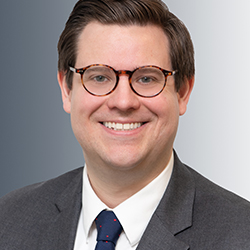Murray v. UBS Securities
In this debut episode of Court Briefs, Kannon Shanmugam is joined by Brian Lipshutz and Will Marks in analyzing Murray v. UBS Securities, a recent Supreme Court decision involving the whistleblower provisions of the Sarbanes-Oxley Act.
- Guests & Resources
- Transcript
Kannon Shanmugam: Welcome to Court Briefs, a podcast from Paul Weiss. I'm your host, Kannon Shanmugam, the Chair of the firm's Supreme Court and Appellate Litigation Practice and Co-Chair of our Litigation Department. In this podcast, we're going to analyze Supreme Court decisions of interest to the business community.
And for our debut episode, we're gonna analyze the court's recent decision in Murray v. UBS Securities, an important case that involved the whistleblower provisions of the Sarbanes-Oxley Act. And in the interest of full disclosure, we filed an amicus brief on behalf of the Chamber of Commerce in this case.
I'm joined today by my colleagues, Brian Lipschitz and Will Marks. So Brian, tell us a little bit about the facts of this case.
Brian Lipshutz: Absolutely. The plaintiff, Trevor Murray, worked for the defendant, UBS Securities. By law, Murray was required to certify that reports he filed with the SEC were independent and accurate. Murray alleged that his supervisors pressured him to write more favorable reports. He blew the whistle on those supervisors within the company, and he was later fired.
Kannon Shanmugam: So Brian, how did this case get to the Supreme Court?
Brian Lipshutz: Murray filed a lawsuit under Section 1514A of the Sarbanes-Oxley Act. That provision makes it unlawful to discharge, demote, suspend, threaten, harass, or in any other manner discriminate against an employee in the terms and conditions of employment because of protected whistleblowing activity.
The Sarbanes-Oxley Act uses a burden-shifting framework to make that showing. Under that framework, a plaintiff must first show that his protected activity was a contributing factor in the unfavorable personnel action. The employer must then show that it would have taken the same unfavorable personnel action in the absence of the protected activity.
A jury found for Murray, but the Second Circuit vacated the verdict. The Second Circuit held that Murray was required to prove that UBS had retaliatory intent. The Supreme Court granted certiorari to resolve a conflict among the courts of appeals on that question.
Kannon Shanmugam: So, Will, tell us what the court decided in this case.
Will Marks: Sure. The court held that a plaintiff need not prove retaliatory intent in the sense of animus or hostile feelings by the employer toward the employee in order to prevail on a Sarbanes-Oxley whistleblower claim.
Kannon Shanmugam: So how did the court reach that conclusion?
Will Marks: The court began by focusing on the word discriminate in Section 1514A, which UBS argued imposed the requirement to prove animus. The court disagreed. It held that the concept of discrimination does not require hostile feelings toward another. Instead, it simply requires that the person be treated differently than others because of some relevant characteristic or conduct, here the reporting activity. Accordingly, the only intent required by the statute is intent to take some adverse employment action against the employee because of the reporting. Animus is simply not part of the equation.
The court then turned to the burden-shifting framework under Sarbanes-Oxley. UBS had argued that the burden-shifting framework was irrelevant because it concerned only the element of causation. The Supreme Court rejected that argument. It held that the burden-shifting framework was designed to get at the question of intent in the sense of whether the employee was treated differently because of the reporting activity. Under that burden-shifting framework, the plaintiff's burden is only to show that the reporting activity was a contributing factor to the adverse employment action.
Finally, the court addressed a policy concern raised by UBS and its amici. The concern was that in the absence of a retaliatory intent requirement, employers may be held liable for making legitimate non-discriminatory employment decisions. The example given by UBS was the situation in which an employee's reporting resulted in the loss of a client, which then left the employee with no work to do. The question is then whether the employer can terminate the employee due to the lack of work, even though the whistleblowing activity led to the lack of work. That question did not trouble the court because it thought that the second step of the burden shifting framework would provide protection in those cases. As the court interpreted the second step, it would apply and provide a defense where the employer would have taken the same employment action in a hypothetical world where the whistleblowing activity did not occur, but all of the other facts remain the same.
Accordingly, the question under UBS is hypothetical, would be whether the employer would terminate the employee due to a lack of work, even if the lack of work was not because of the whistleblowing. Because the answer would likely be yes, the employer would not be liable.
Kannon Shanmugam: So, Will, what are the implications of this decision for employers?
Will Marks: Well, after this decision, it is clear that employers' risk liability, if protected whistleblowing activity plays even a minimal role in a covered employee's decision to terminate or take other adverse action against an employee, as long as a jury could reasonably infer that such a connection exists, the case will likely proceed to trial.
In order to reduce that risk, employers will want to conclude internally and document why they would have taken the adverse action regardless of the whistleblowing activity, which would support the defense under the second step of the burden-shifting framework.
Employers should also know that this decision will likely have ripple effects far beyond Sarbanes-Oxley. There are numerous statutes, such as the amended version of the Food, Drug, and Cosmetics Act, that contain similar whistleblower provisions, using similar language. language. Absent some distinguishing trait, those provisions are likely to be applied in the same manner as Sarbanes-Oxley.
Kannon Shanmugam: Thank you, Will and Brian, for breaking down that important case.
And if you have any questions about the case, please feel free to contact any of us. And for more information about Paul Weiss's Supreme Court and Appellate Litigation practice, please visit us at our website, paulweiss.com.
Thank you for joining us, and until next time, take care.


















